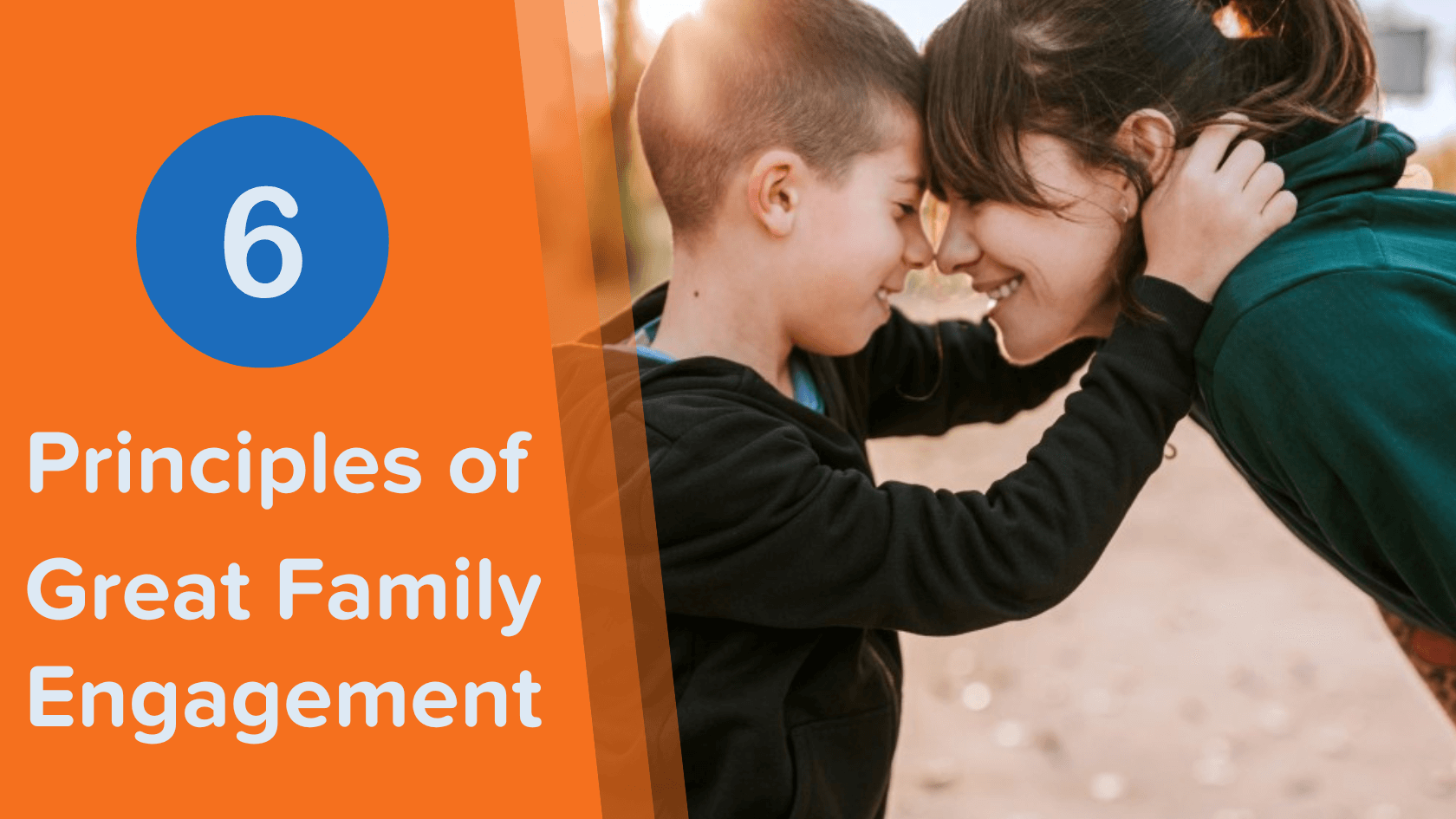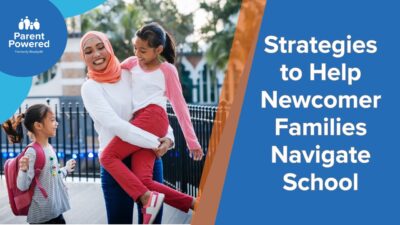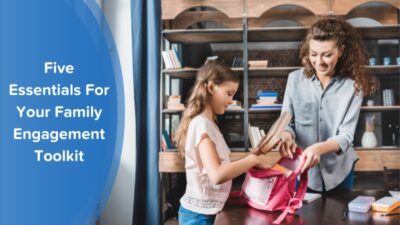by Maren Madalyn, contributing writer
“Families are our most powerful and precious resource.”
This statement grew into a mantra of sorts during my time as a mental health counselor for Special Education classrooms. Our team of counselors, teachers, and school leaders needed partnerships with families and community leaders to help our students overcome trauma or challenges such as gang violence, food security, and more – and learn. We needed a family engagement program.
John’s story
I recall one student in particular (we will call him ‘John’) who joined our classroom in the middle of the school year. After a smooth transition, John demonstrated interest in school and family math activities. Though he was behind his peers in his grade, he seemed eager to learn and practice.

One day, however, John’s behavior abruptly changed. He began avoiding math activities and refused to participate in any way. For the next week, our team puzzled over John’s behaviors, trying to suss out what was causing this new resistance to what he called his favorite subject just days earlier. John refused to share more details, and despite having copious amounts of paperwork from his previous school and teacher, we knew little about John’s home circumstances. Often his mother was not responsive to our outreach. Her neighbors would often pick him up from school, too.
One day, I was on family pick-up duty after school. I walked John and the other students to the parking lot – and spotted John’s mom waiting by her van. It was a perfect opportunity to learn more about what was troubling John.
So I struck up a conversation with her as John clambered into the van.
“How did John do today?” his mom asked after we exchanged pleasantries. I sensed deep anxiety in her voice, the most I ever heard during the few conversations she’d had with our team.
I summarized how John was forming a positive relationship with another boy in our classroom. Yet during a math activity that involved counting coins, John refused to join, claiming it wasn’t ‘real money’ and it was ‘pointless’. This resulted in an argument with his new friend, leaving both boys unhappy.

“Have you noticed John talking about money more at home?” I asked gently.
John’s mom hesitated, then nodded. “In fact, we talk about it every night now. You see, I lost my job last Monday. And I’m scared. I think John is worried about me. About us. And I don’t know what to do.”
The power of family engagement programs
Engaging families — perhaps the most crucial role models in a child’s life — means so much more than a parent-teacher conference, the occasional parking lot conversation, or a scheduled school event. It’s about building a reciprocal relationship between school and home that fosters belonging and trust. It’s about creating an alliance of resources and experts all working together to enable children to thrive in their learning and development.
Research has shown time and time again that active family engagement is essential to cultivate student success. Schools that implement a thoughtful and consistent family engagement program are best positioned to reap its many benefits.

My conversation with John’s mom was a pivotal point in time for our entire classroom team. It underscored the need to establish comprehensive, consistent, and right-sized family engagement strategies – not just for John, but for all of our students. Later in my career, long after this learning moment, I would discover the core principles and practices of effective family-school partnerships and their power to improve student achievement and other learning outcomes.
Six guidelines for effective family engagement programs
We at ParentPowered have collaborated with hundreds of organizations to strengthen their relationships with their community through our suite of family engagement curricula. And we know that there is no one-size-fits-all approach to building strong family and community engagement. Through our experiences, we have seen what it takes to implement the six key guidelines to build family engagement program offerings that contribute to their success.
Let’s break them down and look at examples of how to put each guideline into practice.
1. Design programming with equity in mind
A founding principle for successful family-school partnerships is equity in education. Essentially, it means that schools make every effort available to ensure their events, communications, and connection opportunities are accessible for all family backgrounds in the education system.
Oftentimes the families that benefit most from equitable engagement opportunities are those most underserved, with less access to learning resources. Research synthesized by the OESE highlights that immigrant and refugee communities in particular report greater barriers to engagement with their children’s schools than non-immigrant families. Other challenges such as transportation costs, cultural or language barriers, and major life stressors outside of school impact the capacity of families to dive into their child’s learning, too. These communities – and all families – have so much to gain from a strong home-school partnership.

Make it your own
Explore these examples of equitable family engagement that you can resize to fit into your school offerings:
- Hosting a parent education workshop? Make it virtual. By offering engaging, collaborative, and interactive sessions in the digital space, schools can connect with families that might face barriers to attending in-person events, such as transportation costs. Watch our webinar How to Host a Can’t-Miss Virtual Family Event for tips and best practices about engaging families in virtual settings.
- Want to help new and returning families have a positive public school experience? Give both a leg up with the transition by sharing our Insider’s Guide to Schools. This resource demystifies how parents can easily and consistently participate in their child’s school communities and education.
- Gathering feedback from families about existing opportunities for participation? Ask your students for feedback, too. Students have a unique and valuable perspective to offer, even on activities geared towards partnering with the entire family. Consider putting together student focus groups or surveys to elicit their input. Better still, communicate your findings from these focus groups with families, making them partners in your school’s plans to address students’ needs. Take a look at this Wisconsin school district’s protocols for student focus groups as a starting point for designing your own.
2. Ensure strategies are doable
The most effective family and community engagement involves ongoing opportunities for parents, caregivers, and guardians to connect with their schools and vice versa. Therefore, it is crucial that any family empowerment program is also sustainable and doable for both families and school staff.
Families may face barriers to participating in learning activities. Parents often have a busy schedule, just as educators do, so it can be difficult for them to give significant time to an elaborate project or multi-day activity. Further, activities exclusively held on campus and in-person may be inaccessible for families that live further away, or have work schedules that prevent their attendance.
Schools can recognize the current capacity of parents for engagement by calibrating their offerings to meet these stakeholders where they are. Often the most doable approaches are small and baked into existing daily routines. By breaking down opportunities for participation into simple and low-effort activities, schools help families avoid feeling overwhelmed and encourage consistent participation in their child’s learning. And this cultivates quality education and development for kids!
ParentPowered’s family engagement curricula utilize the FACT – TIP – GROWTH framework to break down learning opportunities into easy steps for families. This approach helps build their knowledge of student development and practical ways to promote their well-being — and research shows that this method of engagement leads to positive learning outcomes!
On the right are two of our favorite activities for families and students to do at home. Contact us to learn more about grade-specific strategies to improve student achievement and even parent-child relationships across age groups.
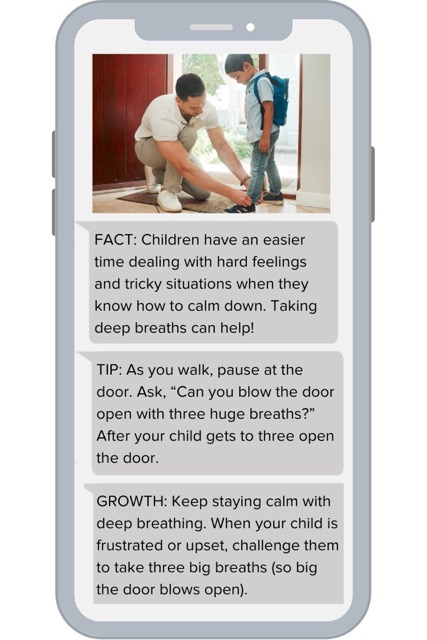
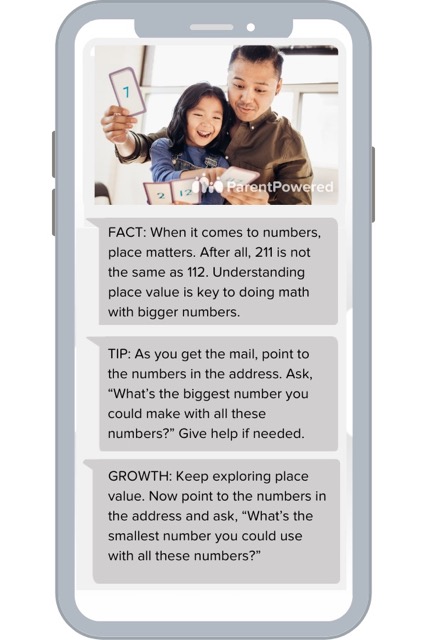
3. Emphasize strengths over gaps
Originating in social work, the term “strengths-based” refers to methods and practices that emphasize a family’s assets or existing strengths that support their students’ success. At its core, these methods assume two things about families. First, families want what is best for their children’s development. Second, families have many resources, knowledge, and other assets in their locale that positively impact their children’s learning.
Strengths-based approaches can deepen the relationship between families and their schools to support student success. For example, teachers can integrate the strengths-based mindset when they connect with parents about student challenges. They can point to and celebrate existing parenting skills used at home that benefit the student. They can also highlight sources of support available to the family – such as after-school education programs at the local library – that contribute to their students’ learning journey.
Rather than target deficits or gaps, strengths-based family engagement concentrates on empowering families to help their children. It encourages schools to reinforce and affirm what parents, caregivers, and guardians are already doing that helps students. Valuing a family as equal partners in their child’s learning journey in turn deepens that family’s trust and respect for their school, which makes for better communication and collaboration when their student struggles.
Make it your own
Here are a few ways that your school can support families to tap into existing assets and apply strengths-based principles to family partnerships:
- Encourage school staff to shift the language used in their family communications. Even simple changes such as moving away from using absolute terms, like “always” and “never”, reflects a growth mindset and moves the tone of conversations towards empowering families.
- Gather family input through multiple channels. Family surveys, parent engagement groups, and even hallway conversations all offer opportunities to hear directly from families about their concerns, desires, and ideas for school improvement. Watch our webinar Family Feedback from Afarfor ways to survey families most effectively. If you work with Spanish-speaking families, read our blog post about the power of surveys with these multilingual families.
- Collaborate with community leaders and local partners. Host workshops during Open House or Back-To-School night that highlight organizations that support families’ basic needs, like financial assistance, food banks, and more. Secondary schools can also partner with the local community college to help high schoolers explore higher education as one of several pathways available to them after graduation. By connecting families with critical resources, schools can boost family capacity and empower them to partner with their schools.
4. Create inclusive opportunities
Culture plays a huge role in how families believe what they should and can do in service of their child’s education. Therefore it is crucial that family engagement programs account for differences in cultural backgrounds, however subtle, to empower diverse families.
When families experience inclusive connection points with their schools (such as events available in their preferred language), it creates a sense of safety and belonging. Additionally, schools send an important message that they recognize and care for their parents, caregivers, and guardians’ well-being. They welcome them exactly as they are — regardless of their past experience.

Last, these efforts signal an important effort to ensure each member of the school community is welcome. Mutual respect begets mutual trust, and trust is a necessary part of any relationship.
Making school activities available in families’ preferred languages is a great place to start with culturally responsive engagement. But schools can move beyond translating school materials to creatively and inclusively encourage community engagement in student learning.
Make it your own
Explore these creative ways to recognize and celebrate a family’s cultural background at your school:
- Post welcome signs and resources around campus (and in at-home communications) in the preferred languages spoken across your families’ homes. That way, whenever families are at school physically, they see themselves reflected in school materials.
- Invite families to share about their cultures and backgrounds with the school community. Hosting guest speakers or sharing spotlights on stories from your families is a wonderful way to celebrate the diversity of expertise and experiences in your school community.
- Encourage your school staff to attend local community events in your families’ neighborhoods. Educators can learn so much about their families from these opportunities. Plus, schools can discover community organizations and resources familiar to their families – which in turn can reinforce strengths-based opportunities to engage with families.
Read our recent post to discover a more detailed breakdown of building inclusive relationships between home and school.

5. Engagement grows with the student
As students grow older and more learned, teachers adapt materials, teaching methods, and curriculum to meet their needs, challenging students to continue their growth and development. The same can be said for engaging families – parents of younger children need different activities and connection opportunities from those of pre-teen or teenagers.
Oftentimes family engagement efforts concentrate on the families of younger grade students, and understandably so. Students experience a huge number of foundational developmental milestones from birth to age 5.
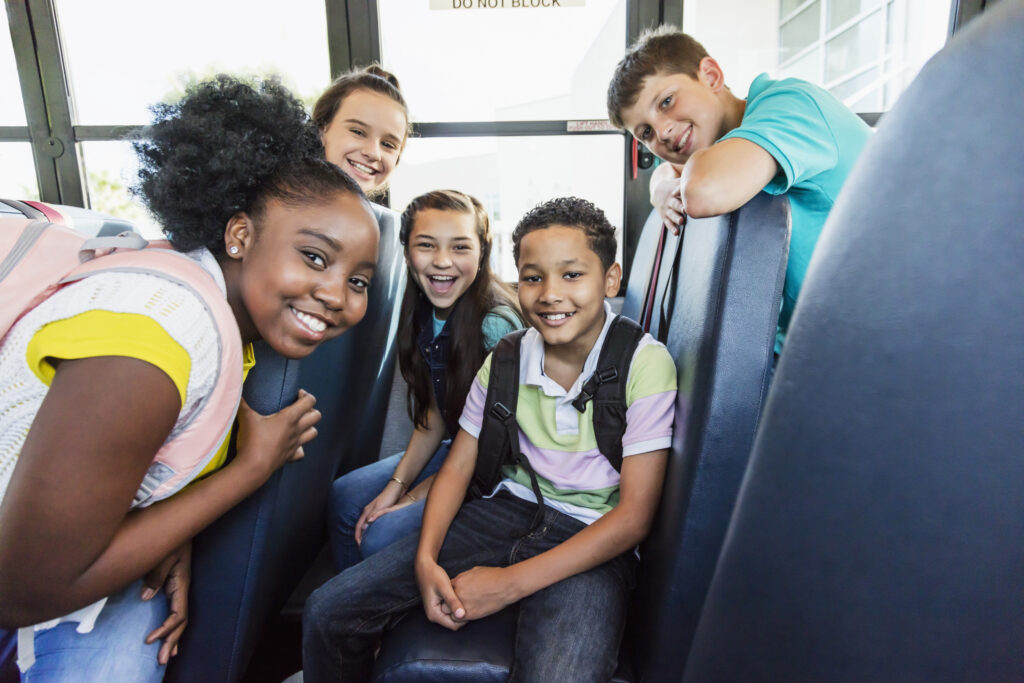
But these students continue to develop and grow into their middle and high school years. And even as they get older, students need continued engagement from their families to nurture academic achievement and social-emotional well-being.
To reinforce a positive learning environment for these growing students, family engagement programs can adapt to the unique needs of middle school and high school families.
Make it your own
Here are a few resources and ideas to help you explore family engagement strategies for schools based on your particular grade levels:
- Preschool: Download our Kindergarten Readiness Kit for your families. It includes fun, easy-to-do activities that fold well into everyday moments.
- Early elementary school: Help your elementary families level up with our School Success Kit. It activities prime students to build their muscles on maintaining focus, creating daily routines, and asking questions.
- Late elementary school: Read more about how we empower families to navigate the immense physical, social, and emotional growth that occurs in the later years of elementary school.
- Middle school: Take a look at our blog post to discover how to cultivate effective middle school family engagement.

6. Cultivate joy and fun
It may go without saying – but learning can be incredibly joyful and fun. In fact, when we experience joy, our bodies benefit in multiple ways as a result of the neurotransmitters processing and sending signals in our brains and bodies.
As educators navigate the evolving effects of the global pandemic, joy has provided and continues to provide an antidote to uncertainty, fear, and loneliness. Fun and joyful family engagement strategies can further bolster family-school community engagement. Ultimately, joy helps build a positive school climate for student success.
Make it your own
Here are a few ideas from the field to inspire you to cultivate joy in your family engagement program:
- Maryland’s Department of Education curated winter-themed family engagement activities specifically for the indoors. This is a handy guide for keeping learning going during cold winter days.
- This extensive list of school family night activities from PTO Answers offers great ideas for fun family engagement. Be sure to offer these activities in ways beyond on-campus events, like through a virtual workshop. Remember, equity is key to positive family-school partnerships!
- In Texas, a unique organization focused on social-emotional health designed an art mural made up of components designed by each of their participating families. This example offers a beautiful and simple way for families to share their stories.
Download our complimentary resource guide for more ways to build joyful relationships with families.

Positive family engagement enhances a child’s life and well-being
As I reflect on John’s story, I can see how these principles were naturally in play as our team stepped into action to support John and his mom. With our classroom therapist, we connected John’s mom with local resources available to aid her job search and financial planning. We ensured family therapy meetings were accessible to John’s mom, always scheduled just before or after pick-up and drop-off times. As a team, John’s mom and our counselors practiced doable strategies like ‘worry’ check-ins with John that easily transferred between home and school.
Two months after we launched this program, John’s hand was repeatedly jumping up during our math ‘quiz bowl’ games, and he was counting coins like a champ.
This is the power of family engagement programs, of partnering with families – truly educators’ most powerful and precious resource.
Get inspired with your family engagement program planning with this research round-up.

About the author
Maren Madalyn has worked at the intersection of K12 education and technology for over a decade, serving in roles ranging from counseling to customer success to product management. She blends this expertise with fluid writing and strategic problem-solving to help education organizations create thoughtful long-form content that empowers educators.

